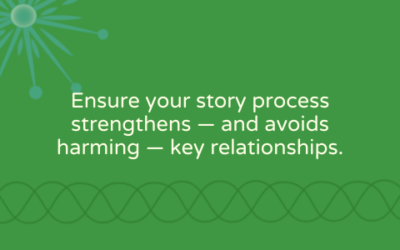One of the core areas of focus in my business is story writing. I enjoy the work, and I learn something from every story I write. I also just like helping nonprofit communicators get their stories written – something I’ve been doing for one of my long-term clients, Sarah McPherson at The Oakville Community Foundation.
Getting started with a new round of stories
I’ve developed content for Sarah for many different projects, and a few years ago, she asked me to help her to grow the Foundation’s story bank. Sarah, who is the organization’s Director of Philanthropy & Communications, needed stories that would highlight the impact of four of the organization’s funded agencies.
 “Most of our funds are Donor Advised, which means our Fundholders make the majority of decisions with respect to where the dollars are directed,” explains Sarah. “So, at The Foundation, we work extremely closely with our Fundholders to provide them insights, education, involvement and experience with what and where the needs are, and how they can play an active role in the bettering of our community as a whole. The people, the stories they tell and share with us from the Agencies who serve and support those in need, are truly what drives the engagement.”
“Most of our funds are Donor Advised, which means our Fundholders make the majority of decisions with respect to where the dollars are directed,” explains Sarah. “So, at The Foundation, we work extremely closely with our Fundholders to provide them insights, education, involvement and experience with what and where the needs are, and how they can play an active role in the bettering of our community as a whole. The people, the stories they tell and share with us from the Agencies who serve and support those in need, are truly what drives the engagement.”
Sample: agency story, used in a past Foundation annual report [pdf]
Since our initial round, I’ve written many stories for The Oakville Community Foundation. For each story, I start by asking Sarah for necessary information including whom to feature and interview, as well as the focus of each story. When writing particularly large volumes of stories, I set up a story writing tracker to keep me organized and to keep Sarah informed of my progress. I then arrange and conduct the necessary interviews, draft and organize the review of each draft by the agencies and submit the draft stories to Sarah.
Story writing challenge: striking the right (and sometimes delicate) balance
Sarah explains that another reason storytelling is important to the Foundation is to share in the generosity and caring Fundholders play in the vitality of the community. When writing these stories it’s important to find a balance between the organization’s key messages and the information individuals want us to share – which can sometimes be challenging.
“A few years ago, we featured a long-standing Fundholder family, and we wanted to tell the story of how they came to establish a fund and work with us. The Fundholder had a different perspective. He wanted the story told, but insisted that his child be the focus of the piece and not him and his wife. Well, this complicated things as it also needed to fit into our full narrative. We wanted to tell the story of why he and his wife first established the fund – but the Fundholder wanted the story to be about the next generation,” explains Sarah.
“It was a difficult story to tell. We managed to bring into the story the original founders’ piece, while also telling the next generation, however, in truth, without Marlene’s guidance, this story would not have made the presses. Through her diligence, careful consideration of the founders and the founders’ wishes today, she was able to craft a story that today is one of my favourites to read.”
Sample: Fundholder story, published on The Foundations’ website
The value of dedicating resources to story writing
According to Sarah, The Foundation is judicious about what they share through stories as well as where and how they share them. They incorporate stories on social media, especially immediately following report releases, including Vital Signs reports, other research reports, and annual reports. They also incorporate stories on the organization’s website and share them when meeting with potential new Fundholders.
Writing stories for @OakvilleCF (case study): challenges, benefits, and other behind the scenes Click To TweetI recently asked Sarah whether she thinks all nonprofit organizations should put deliberate effort into building a story bank.
“Nonprofits are in the business of relationship building. Our audiences are drawn to narratives, and stories that make us feel fundamentally human. Using stories brings people into the discussion and builds their interest based on emotion, based on their values and not based on what’s in it for me,” Sarah responded. “And having someone outside of the organization looking at a year of work, and summarizing it into a theme, a narrative and a positioning on how to tell more stories, has been a direct benefit. The advantage of this is helping to keep a constant conversation going and inspiring others to let us tell their stories.”
Do you need my help with story writing?
“Storytelling is probably the most compelling and engaging tool in our toolbox at The Foundation,” says Sarah. “And working with Marlene is a joy! She has a passion for being able to see a story, and to tell it in a manner that not only brings happiness to the donors, but also to others that read it and share it!”
If you’re convinced of the value of storytelling but know that you need help pulling it all together, check out my Storybank starter package: profile/case study writing and get in touch with me.
Writing stories for a community foundation (case study) #nonprofit #storytelling Click To Tweet
![Writing stories for a community foundation [case study] Writing stories for a community foundation [case study]](https://moflow.ca/wp-content/uploads/2018/07/OCF-stories-casestudy.png)


